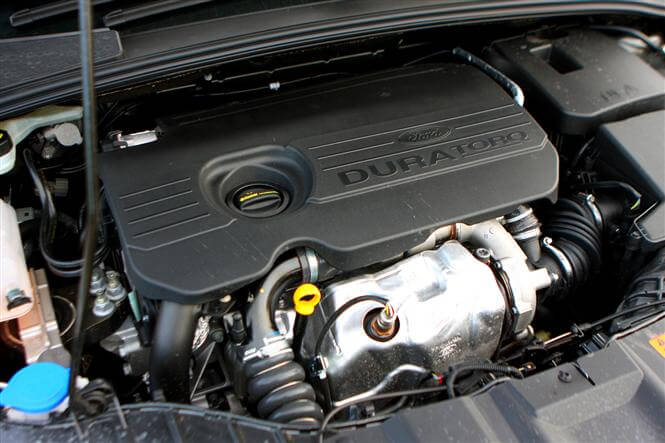
We’ve being doing lots on DPF issues in the last 6 months but for some reason we’ve completely ignored the top selling car manufacturer in the UK. Well that’s all about to change with our mighty Ford DPF frequently asked questions page. We’ll be adding to this page as much as possible so please let us know your experiences, tips and information in the comments below. We hope you find this page helpful so please share, like and comment so this page can help as many of your fellow Ford owners as possible. We’ve added lots of internal links to our website to help give you as much information on DPFs as possible.
Ford DPF Fluid (eolys)
Some Ford models (which models TBC) employ a DPF fluid called eolys. Eolys is a cerium/iron based solution which is designed to assist in DPF regenerative during normal driving conditions. This solution isn’t the silver bullet we all hope for but it has proven to help prevent DPF regeneration during normal driving conditions.
Its contained in a little tank behind the fuel tank any is added to the fuel system automatically. It’s suggest that the tank should be refilled every 37500 miles and if for any reason its empty the car will throw up an error and not attempt any form of DPF regeneration. At presenf we’re unsure if it caused any type of limp home mode or power loss with the eolys error.
Can I refill the Ford DPF Fluid (eolys) myself?
We’ve trawled the Ford owners forums and it’s agreed that you are able to refill the eolys tank yourself. Weather or not this is a good idea is not my call. It’s part of your vehicles service schedule (75k we understand) and we would sway towards just letting them do it. It may add around £100 to your bill but at least you know its the right fluid and it’s done correctly.
Having it done by Ford could be in your favor if you have a complaint or issue within your warranty period, even though DPF filters are not commonly covered by even the most inclusive of vehicle warranties.
Shhhh! But how can I do it?!
We’ve not had any first hand experience filling the eolys tank but we found a nice man that has and apparently its a dirty ****ard of a job.
The tank is located just behind the fuel tank and features a filling pipe to the side of the unit. The plug has a cap on the end which can be a little fiddly without the car up in the air.
If completely empty it will take about 1.8 ltrs to fill. The fluid and refill kit can be obtained from Eurocarparts and will cost you a little short of £50.
You’ll also have to clear the error on the ECU so the system can start using the fluid in the correct manner again.
We can’t go into detail but I’m sure if you ask in the right place someone will be on hand to guide you through the dirty process. Thanks for Andy.B1971 for posting this information on the http://www.fordownersclub.com forum.
DPF Information / Guides
With that out of the way please find below the details for each Ford Model. Below are some quick links to help you jump down the page without scrolling. There’s quite a wall of text and pictures below.
Quick jump:
- Fiesta
- Focus
- Mondeo
- Other Models
- Lost Manuals
- Common Ford DPF issues
- DPF Cleaning Aditives
- DPF Removal
[ad]
Fiesta
The mighty Fiesta. Its been the number one selling car in the UK for longer than we can care to remember. Unfortunately the super-mini has been equipped with a DPF filter since before 2006. Please find below extracts from the manual.
Fiesta 2006 – 2012
From the Manual:
DIESEL PARTICULATE FILTER (DPF)
The DPF forms part of the emissions reduction systems fitted to your vehicle. It filters harmful diesel particulates (soot) from the exhaust gas. Regeneration WARNING Do not park or idle your vehicle over dry leaves, dry grass or other combustible materials. The DPF regeneration process creates very high exhaust gas temperatures and the exhaust will radiate a considerable amount of heat during and after DPF regeneration, and after you have switched the engine off. This is a potential fire hazard.
Unlike a normal filter which requires periodic replacement, the DPF has been designed to regenerate, or clean itself to maintain operating efficiency. The regeneration process takes place automatically. However, some driving conditions mean that you may need to support the regeneration process.
If you drive only short distances or your journeys contain frequent stopping and starting, occasional trips with the following conditions could assist the regeneration process:
- Drive your vehicle, preferably on a main road or motorway, for up to 20 minutes avoiding prolonged idling, but always observing speed limits and road conditions.
- Do not switch off the ignition.
- Use a lower gear than normal to maintain a higher engine speed during this journey, where appropriate.
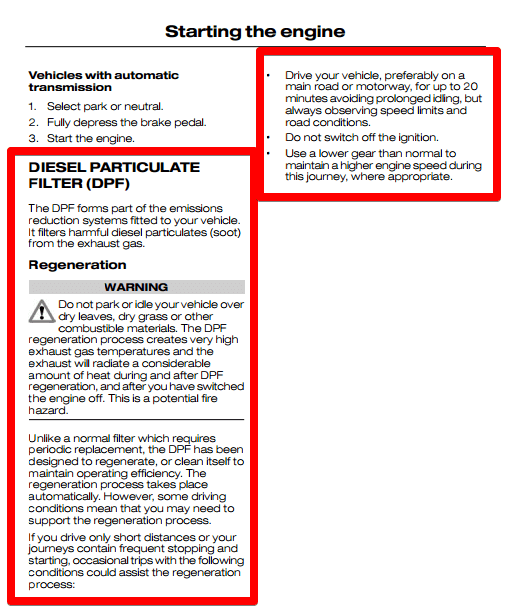
As you will see – Ford are a very unspecific with regards to the exact speed and RPM required. I would aim for about 70MPH in 4th or 5th (6th gear dependent). The revs should be in excess of 2000RPM. Please note that excessive sustained revs (RPM) will not aid the regeneration process, don’t waist your fuel or damage your engine.
Fiesta 2012 – Present
Thankfully Ford have give owners of the new Ford Fiesta much more to work with. But sadly they do not give the option for a manual regeneration like in the new Focus and
Here’s what the online manual says
If your journeys meet one of the following conditions:
- You drive only short distances.
- You frequently switch the ignition on and off.
- Your journeys contain a high level of acceleration and deceleration.
You must carry out occasional trips with the following conditions to assist the regeneration process:
- Drive your vehicle in more favorable conditions, which you will find at higher vehicle speeds in normal driving, on a main road or freeway for a minimum of 20 minutes. This drive may include short stops that will not affect the regeneration process.
- Avoid prolonged idling and always observe speed limits and road conditions.
- Do not switch the ignition off.
- Select a suitable gear to ideally maintain engine speed between 1500 and 3000 RPM.
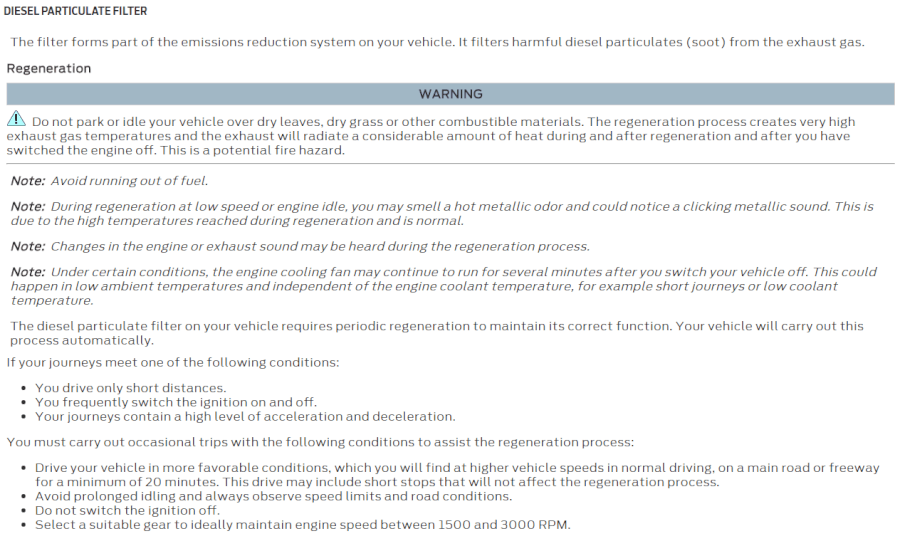
Focus
Focus 2007 to 2010
This information is much like the Fiesta however their 2007 Focus owners manual seems to be missing the juicy information we need. Our informed guess that is a regeneration would require a speed over 40MPH with revs around 2000 – 2500 RPM.
- Drive your vehicle at a constant speed, preferably on a main road or motorway, for up to 20 minutes.
- Avoid prolonged idling and always observe speed limits and road conditions.
- Do not switch off the ignition.
- Use a lower gear than normal to maintain a higher engine speed during this journey, where appropriate.
Focus 2010 to 2015
We’re not going to recopy all of the information above as google hates duplicate copy but trust us when we say its the same as the older Focus.
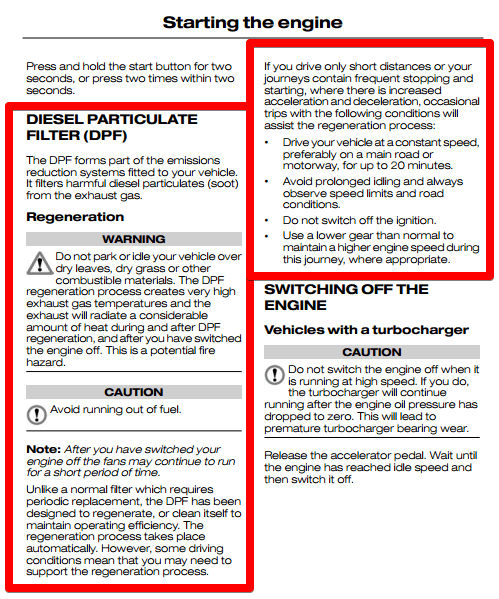
Focus 2015-Present
Wow! Ford went to town with this lot! They have even given owners the option to perform a manual regeneration without getting turned over by a dealer. We know first had that this can be a costly affair having personally spent nearly £1000 for manual regeneration in my 2008 Qashqai.
We’d like to hear from you if you’ve used this feature – successfully or not! Please please do get in touch.
WARNING
To avoid damaging the diesel particulate filter:
- Do not crank the engine for more than 10 seconds at a time.
- Do not push-start or tow-start your vehicle. Use booster cables.
- Do not switch the ignition off when your vehicle is moving.
- Do not ignore warning lamps or information messages regarding exhaust system cleaning and regeneration.
Where vehicle use meets any of the following conditions:
- Driving short distances.
- Prolonged engine idling.
- Frequently switching the engine on and off.
- High levels of acceleration and deceleration.
We recommend you assist the regeneration process by:
- Avoiding prolonged engine idling.
- Driving your vehicle in a manner to allow effective cleaning.
Diesel particulate filter warning lamp.
Before you start manual regeneration, do the following:
- Park your vehicle outside of any enclosed structure.
- Make sure the transmission is in park (P) or neutral (N).
- Make sure the parking brake is on.
- Park your vehicle a minimum of 3 m from any obstructions and materials that can easily combust or melt, for example, paper, leaves, fuels, plastics and other dry organic material.
- Make sure there is a minimum of 12 L of fuel in the fuel tank.
- Check the engine oil level.
- Check the engine coolant level.
Use the manual regeneration feature when:
- You are not able to drive in a manner that allows effective automatic cleaning. See Diesel Particulate Filter Automatic Regeneration.
- You choose to manually start the regeneration process when the engine is idling.
| Message | Action and Description |
|---|---|
|
Settings
|
Press the OK button or the right arrow button. |
|
Exhaust Filter Full Clean Soon
|
Press the OK button or the right arrow button. |
| Select one of the following: | |
|
Exhaust Filter at Limit Clean Now
|
Press the OK button or the right arrow button. Follow the prompts regarding exhaust position as required to start manual regeneration. Make sure you understand each prompt. The information display confirms that regeneration has started and when it is completed. |
|
Exhaust Filter Overloaded Clean Now
|
Press the OK button or the right arrow button. Follow the prompts regarding exhaust position as required to start manual regeneration. Make sure you understand each prompt. The information display confirms that regeneration has started and when it is completed. |
| Message | Action and Description |
|---|---|
|
Information
|
Press the OK button or the right arrow button. |
|
Driver Assist
|
Press the OK button or the right arrow button. |
|
Auto Exhaust Cleaning Off
|
Check the box to switch automatic regeneration off. Uncheck the box to switch automatic regeneration on. |
Mondeo
Mondeo 2007 – 2015
The process from the other Mondeo is exactly the same as both the other Focus and Fiesta guidance. Here’s the pages from the manual.
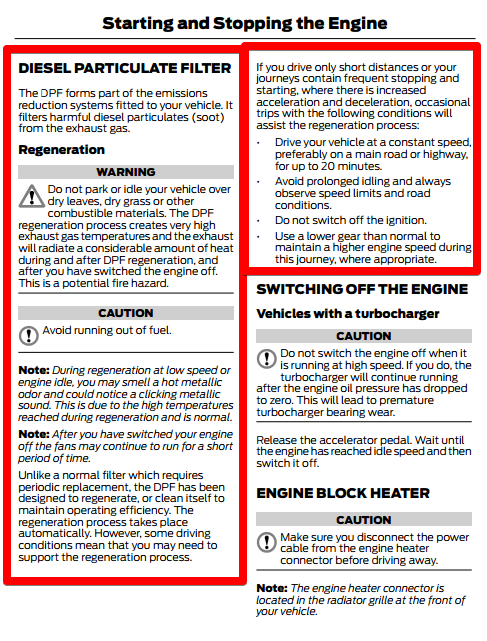
Mondeo 2015 – Present.
Strangely, unlike the Focus the Mondeo manual suggests that it does not have a way of performing a manual DPF regeneration process. Considering the Mondeo is Ford’s flagship model it’s missing such a handy features that it’s little brother has – or it could be that they have simply missed it from the manual. We’ll get in touch with Ford and ask them for confirmation. Until we can confirm this please see below from the Mondeo 2015 – present manual.
DIESEL PARTICULATE FILTER
If your journeys meet one of the following conditions:
- You drive only short distances.
- You frequently switch the ignition on and off.
- Your journeys contain a high level of acceleration and deceleration.
You must carry out occasional trips with the following conditions to assist the regeneration process:
- Drive your vehicle in more favorable conditions, which you will find at higher vehicle speeds in normal driving, on a main road or freeway for a minimum of 20 minutes. This drive may include short stops that will not affect the regeneration process.
- Avoid prolonged idling and always observe speed limits and road conditions.
- Do not switch the ignition off.
Other Models
We’ve not been doing too much digging about the DPF systems, issues and regeneration processes for other DPF equipped Fords. However we suspect that with Ford’s common engine platforms they will also make use of DPF Fluid (eolys) additive and have similar regeneration conditions and requirements.
Please seek advice from your handbook or contact your Ford dealer.
We’ll be adding to this article over time so if you have another Ford Transit, Kuga, Ka etc.. and have any experiences (good or bad) with your DPF then please let us know in the comments.
Lost your manual?
If you’ve lost your Ford manual then Ford have helpfully provided a hand page which you can download them from. Click here for the Ford Online Manuals
Common Ford DPF issues
Unlike VAG cars, Fords don’t seem to have the chronic DPF sensor issues plaguing it unlike VW, Skoda, Audi and Seat diesel models. Much of our investigation has shown that Ford’s DPF systems are on the whole pretty good. Unfortunately you still won’t be able to escape DPF issues for the entire cars lifetime as the ASH produced from diesel engines can not be burnt off during a DPF regeneration.
Unlike other models of car Ford seems to get off quite lightly with regards to premature DPF failures. We suspect that this has something to do with the eolys fluid in use by certain models. We have also seen developments in DPF technologies in newer cars, helping DPF regenerations in less than ideal conditions and driving habits.
DPF Cleaning Additives
A Manual DPF regeneration at a Ford or independent garage will cost you upwards of £200. We suggest that before you hand over the keys try out one of the many DPF cleaning additives available. These additives are added to the fuel tank and work by helping reduce the the temperature which the soot blocking your DPF burns off. You’ll still need to take the car for a run and meet certain criteria (as above) but it just might save you over £200 in unneeded repair bills. We appreciate that the Ford DPF fluid (eolys) is designed to do such a job but for the sake of a tenner its well worth a shot before you hand over your hard earned cash for a manual DPF regeneration or even DPF replacement.
You can find out more about these additives on our on our DPF cleaning page.
Halfords offer DPF cleaning services but please save your money and buy some DPF cleaning fluid yourself, its a total rip off. More here about Halfords DPF cleaning services.
Amazon stock a huge selection of DPF cleaning fluids – below are some very popular ones available.
DPF Removal
If you’ve found this page then no doubt you’ll have also read about the DPF removal services offered by countless garages and mobile mechanics. This services involves gutting the DPF and “remapping” the ECU to remove the DPF system from its brain. We’ve already covered why not to remove the DPF in this article about the DPF MOT failure but in short here’s why we stongly suggest you shouldn’t do it.
- It IS illegal to modify your vehicle in a way that impacts the emissions. Many DPF removal services cover their back by stating its for “off road” use only.
- Without a DPF your car WILL fail its MOT. At present its only a visual check but plans are in motion to have the MOT changed to help detect this.
- Your insurance might be void. Lets say you have an accident and you plough into another car writing things off and causing injuries to other parties. When you car is checked by the inurance company it’s noted that your DPF has been remove. Bye bye insurance and possible legal action headed your way.
We need your help!
We’re always looking to add more information to all our pages, so if we’ve left something out, you have a suggestion or correction then please leave a comment below.
Helpful Articles
You might also find the following articles below of use
- The Diesel particulate filter (DPF) FAQ
- The Exhaust Gas Recirculation Valve EGR FAQ
- Our top five tips on keeping your DPF clean
- Diesel remap & tuning boxes will my diesel particulate filter DPF cope?
- DPF Cleaning specialists reveal top 10 vehicles with DPF issues
- Which cars have the most DPF problems?
- Skoda Octavia iii 2013 Diesel Particulate Filter DPF – Owner’s Manual – Regeneration FAQ
- Hypermiling Top Tips: Top 5 causes of blocked / Failed DPF diesel particulate filters
** Content from the manuals as per this page were taken from the Ford Owners manual pages. It’s their content as could be liable to change at any time.


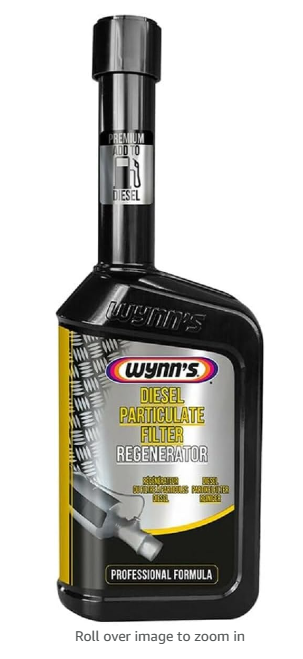
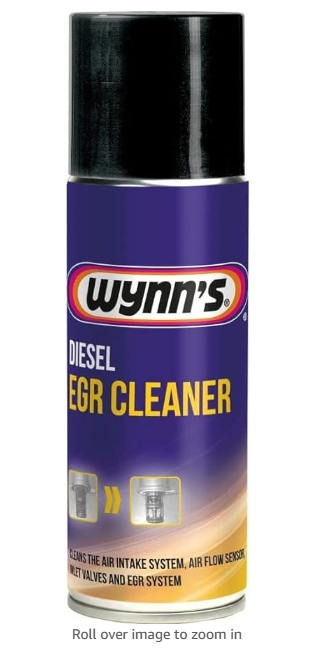
to add to your list of DPF woes, i have a 2015 focus which a main ford dealer has failed to repair or EVEN diagnose on 3 separate occasions. The symptoms as described by other ford focus drivers are all evident on mine. Out of desperation i took the car to another ford dealer who diagnosed the fault as the dpf would not regenerate, and hence required replacement.The car has been with the dealer for 3 weeks! i am told that the dpf is on” back order”, as there are no new ones in the country!! To make matters even worse the lease company who i lease the car from, and ford were arguing about who was going to foot the bill,for the 1st week, even bearing in mind that the car has done around 80,000 miles. i have always been a ford fan, but this experience WILL make me buy a different make of car later this year when my lease is up for renewal.
I got the same crap from my Ford Dealer in regards to sourcing a new replacement DPF – I caused Murder and they found one the next day.
Have a look at the oil being used?
ACEA recommend “C” catogory oils for use with DPFs.
With DPFS there are two issues. Soot and ash.
Soot you can “burn off” regenerate but ASH builds up and does not burn off and over a time period can block the filter.
Ford 913d specifications show Sulphated Ash no greater 1.3 -Cross over to ACEA A5/B5 which show the ash content no greater 1.6)so these oils can contain a high ash content.
Mid Ash is below 0.8.
Note
*boron oil additives contains ash but on tests show it does not block the filter.
ACEA A/B: Gasoline and Diesel Engine Oils – “High SAPS”
ACEA C: Catalyst & GPF/DPF compatible Engine Oils for Gasoline & Diesel Engines – “Low SAPS”
I have a 2015 (65) Ford Mondeo 210HP BI turbo. I had a fault code of P2463 (Soot ACC) @ 28k miles and Ford swapped the DFP under Warranty and the Fuel Vapouriser. Not the Best service or experience but I appreciated it none the less. They stung me for £220 for a service though. Now at 50k miles, the same thing has happened. Its due to go back in this week but at 60k miles it’s out of Warranty. The EML will not go off. Ive read the P2463 code only comes on once the filter is 95% blocked. I mean WTF, the light only comes on once the filter is knackered. Great. I regret buying this car and Im getting shut of it after it, hopefully, repaired. Never buying a diesel again.
I don’t even think its the DFP that’s at fault I think that’s just a symptom of the fault. I like the car but once out of warranty, it’s too expensive to repair every 20k miles.
I have a focus 2017 automatic, I am getting engine failure after the regeneration which causes significant shuddering, the engine management light comes on and the warning is engine service due vehicle cannot be restarted for a minimum of 2 hours, Ford have no explanation as to why this happens or what can be done to alleviate the issue, I drive for 3-4 hours mainly on high speed duel carriageways and motorways twice weekly and do not engage in short journeys
Ford appear to believe it is acceptable as the issue is not perminant and does not cause the vehicle to be inoperable between incidents
Recent technical information (not in specific relation to this model) would indicate there are issues relating to emissions processes on newer cars causing similar problems
I would value your feedback on this